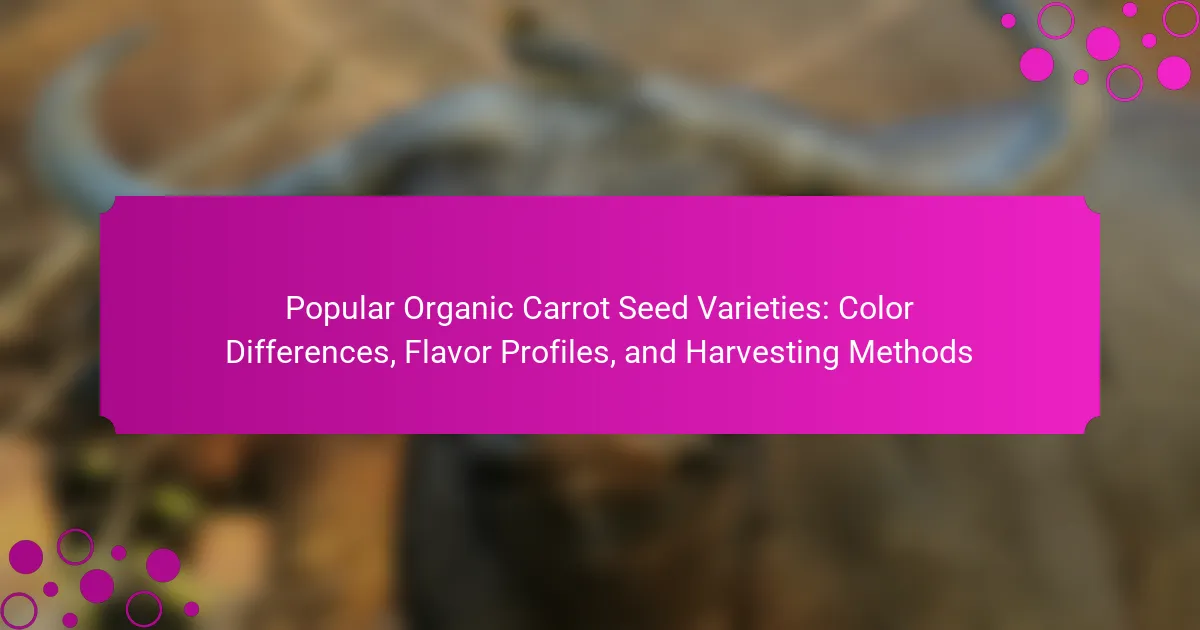The article focuses on popular organic carrot seed varieties, specifically ‘Nantes’, ‘Imperator’, and ‘Danvers’. Each variety is characterized by distinct features: ‘Nantes’ is recognized for its sweet flavor and cylindrical shape, typically growing 6-7 inches long; ‘Imperator’ is favored for its crisp texture and longer, tapered shape, reaching up to 10-12 inches; while ‘Danvers’ is known for its robust, earthy flavor and adaptability to various soil types, growing about 7-8 inches. The article will explore color differences, flavor profiles, and effective harvesting methods associated with these carrot varieties, providing valuable insights for organic gardeners.

What are the popular organic carrot seed varieties?
Popular organic carrot seed varieties include ‘Nantes’, ‘Imperator’, and ‘Danvers’. ‘Nantes’ is known for its sweet flavor and cylindrical shape. This variety typically grows to about 6-7 inches in length. ‘Imperator’ has a longer, tapered shape and is often favored for its crisp texture. It can reach lengths of up to 10-12 inches. ‘Danvers’ carrots are robust and have a rich, earthy flavor. They are well-suited for various soil types and can grow to about 7-8 inches. These varieties are commonly chosen by organic gardeners for their taste and adaptability.
How do color differences impact the appeal of carrot seed varieties?
Color differences significantly impact the appeal of carrot seed varieties. Brightly colored carrots, such as purple and yellow, attract consumer interest and enhance marketability. These colors are often associated with unique flavors and higher nutrient content. Research indicates that colorful carrots can have higher levels of antioxidants compared to traditional orange varieties. For example, purple carrots contain anthocyanins, which are beneficial for health. The visual diversity appeals to consumers seeking variety in their diets. Additionally, farmers may choose vibrant colors to differentiate their products in competitive markets. Thus, color differences play a crucial role in consumer preferences and agricultural choices.
What are the different colors of organic carrot seeds available?
Organic carrot seeds are available in several colors. The common colors include orange, purple, yellow, and white. Each color represents a different variety of carrots. Orange carrots are the most popular and are rich in beta-carotene. Purple carrots contain anthocyanins, which provide antioxidant benefits. Yellow carrots have a milder flavor and are high in lutein. White carrots lack pigment but still offer a crunchy texture. These color variations reflect genetic diversity in carrot cultivation.
How do these color differences affect growth and taste?
Color differences in carrots can significantly affect their growth and taste. Carrots with deeper pigmentation often contain higher levels of antioxidants. For example, orange carrots are rich in beta-carotene, which contributes to their sweet flavor and vibrant color. Purple carrots, on the other hand, contain anthocyanins that may enhance their taste profile and provide unique health benefits.
The growth conditions can also vary based on color. For instance, yellow and orange carrots thrive in slightly different soil pH levels compared to purple varieties. Research shows that these color differences can influence nutrient uptake, which directly impacts flavor. The taste of carrots can range from sweet to earthy, depending on the variety and its growing conditions. Thus, the color of carrots serves as an indicator of their growth requirements and potential taste characteristics.
What flavor profiles can be expected from various carrot seed varieties?
Carrot seed varieties exhibit diverse flavor profiles. For example, ‘Nantes’ carrots are known for their sweet and crisp taste. ‘Imperator’ carrots have a strong sweetness with a hint of earthiness. ‘Danvers’ varieties provide a robust flavor, balancing sweetness and spiciness. ‘Chantenay’ carrots are often described as rich and slightly nutty. ‘Purple Haze’ carrots offer a unique sweet flavor with floral notes. ‘Baby’ carrots, regardless of variety, tend to have milder and sweeter flavors due to their smaller size. Different growing conditions and soil types can also influence these flavor profiles.
How does the flavor vary among different organic carrot types?
The flavor of organic carrots varies significantly among different types. Orange carrots are known for their sweet and slightly earthy flavor. Purple carrots often have a more robust taste with hints of spiciness. Yellow carrots tend to be milder and sweeter than their orange counterparts. White carrots have a subtle flavor with less sweetness. Each type’s flavor is influenced by its sugar content and growing conditions. For example, the sweetness of carrots can increase with proper sunlight and soil quality. These flavor differences make each variety unique and suitable for various culinary uses.
What factors influence the flavor profile of organic carrots?
The flavor profile of organic carrots is influenced by several factors. Soil quality plays a crucial role in flavor development. Nutrient-rich soil enhances sweetness and overall taste. Water availability also affects flavor; consistent moisture leads to better flavor profiles. The variety of the carrot contributes significantly; different cultivars have unique taste characteristics. Climate conditions impact flavor as well; warmer temperatures can increase sweetness. Harvest timing is essential; carrots harvested at peak maturity have superior flavor. Lastly, post-harvest handling can affect taste; improper storage can diminish flavor quality.
What are the common harvesting methods for organic carrots?
Common harvesting methods for organic carrots include hand harvesting and mechanical harvesting. Hand harvesting involves manually pulling carrots from the soil. This method is often used for smaller plots and ensures minimal damage to the carrots. Mechanical harvesting uses specialized equipment to uproot carrots efficiently. This method is suitable for larger fields and can increase productivity. Both methods require careful timing to ensure optimal flavor and texture. Carrots are typically harvested when they reach a specific size, usually between 1 to 2 inches in diameter. This size ensures the best taste and marketability.
How do harvesting methods differ among carrot seed varieties?
Harvesting methods differ among carrot seed varieties primarily due to their growth characteristics and maturity timelines. For example, some varieties, like Nantes, are harvested when the seeds are fully mature and dry on the plant. Other varieties, such as Danvers, may require earlier harvesting to prevent shattering.
The harvesting technique can also vary; some seeds are collected by hand to ensure quality, while others are harvested mechanically. Mechanical harvesting is more common for larger-scale operations and specific varieties that can withstand such methods.
Additionally, the timing of the harvest is crucial. Late-maturing varieties may need to be monitored closely to avoid seed loss. Research indicates that seed quality can significantly decline if harvested too late or too early, affecting germination rates.
What tools and techniques are recommended for harvesting organic carrots?
Recommended tools for harvesting organic carrots include a garden fork, spade, and hand trowel. A garden fork helps loosen the soil around the carrots. This method minimizes damage to the roots. A spade can also be used to lift the carrots from the ground. Hand trowels are effective for smaller or delicate varieties.
Techniques for harvesting involve checking for size and maturity first. Carrots are typically ready when they reach about 1 inch in diameter. Gently pull the foliage to expose the roots before harvesting. Avoid pulling too hard to prevent breakage. After harvesting, brush off excess soil without washing. This preserves the carrots’ shelf life.
How can the choice of carrot seed variety affect the yield?
The choice of carrot seed variety significantly affects the yield. Different varieties have unique growth characteristics and adaptability to soil conditions. For instance, some varieties are bred for higher disease resistance, which can lead to better survival rates and increased yield. Research shows that hybrid varieties often produce higher yields than open-pollinated ones due to their enhanced vigor and growth rates. Additionally, specific varieties may perform better in certain climates, impacting overall productivity. Selecting the right variety based on local conditions can optimize yield potential.
What are the best practices for growing organic carrots?
The best practices for growing organic carrots include selecting the right soil, ensuring proper spacing, and maintaining consistent moisture. Carrots thrive in loose, well-draining soil with a pH between 6.0 and 6.8. It is essential to amend the soil with organic matter to enhance fertility. Spacing seeds about 2-4 inches apart allows for healthy root development. Consistent moisture is critical, especially during germination, which takes 10-20 days. Mulching can help retain moisture and suppress weeds. Additionally, rotating crops each year prevents disease buildup in the soil. Organic pest control methods should be employed to protect the crop without synthetic chemicals. These practices lead to healthier, tastier carrots and increase yield.
How can soil quality impact the growth of organic carrot varieties?
Soil quality significantly affects the growth of organic carrot varieties. Healthy soil provides essential nutrients, moisture retention, and proper aeration. Carrots require loose, well-drained soil for optimal root development. Compacted or poor-quality soil can lead to stunted growth and misshapen roots. Soil pH also plays a crucial role; carrots thrive in slightly acidic to neutral pH levels (6.0 to 7.0). Nutrient-rich soil enhances flavor and sweetness in carrots. Studies indicate that organic practices improve soil structure and microbial activity, benefiting carrot growth.
What are the ideal growing conditions for different carrot seed varieties?
Carrot seed varieties thrive in well-drained, sandy loam soil. The ideal pH level for growing carrots is between 6.0 and 6.8. Carrots require full sun, ideally receiving 6 to 8 hours of sunlight daily. They grow best in cool temperatures, ideally between 60°F to 70°F. Adequate moisture is crucial, with consistent watering to keep the soil evenly moist. Different varieties may have specific needs; for example, Nantes carrots prefer looser soil for optimal growth. Additionally, early spring or late summer planting is recommended for various carrot types to avoid heat stress.
What tips can ensure a successful harvest of organic carrots?
To ensure a successful harvest of organic carrots, start by choosing the right variety suited for your climate. Select a well-draining, loose soil for optimal root development. Maintain consistent moisture levels throughout the growing season. Thin seedlings to prevent overcrowding, allowing each carrot sufficient space. Apply organic mulch to retain soil moisture and suppress weeds. Monitor for pests and diseases, using organic methods for control. Harvest carrots when they reach the desired size, typically 1 inch in diameter. Pull gently to avoid breaking the roots. Proper timing ensures better flavor and texture.
The main entity of this article is popular organic carrot seed varieties, which include ‘Nantes’, ‘Imperator’, and ‘Danvers’. The article provides an overview of these varieties, highlighting their unique attributes such as color differences, flavor profiles, and ideal growing conditions. It discusses how color impacts consumer appeal and nutrient content, as well as the influence of soil quality and moisture on growth and taste. Additionally, the article covers common harvesting methods and best practices to ensure a successful yield of organic carrots, emphasizing the importance of selecting the right variety for optimal results.
